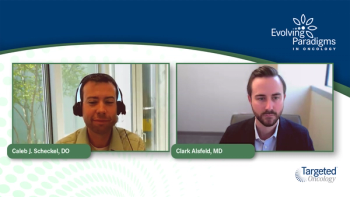
Third Generation BTKi and Unmet Needs
Drs Shadman and Cohen introduce new data concerning a third-generation BTK inhibitor, pirtobrutinib, and discuss unmet needs in the B-cell malignancy landscape.
Episodes in this series

Mazyar Shadman, MD, MPH: Last year at ASH [American Society of Hematology Annual Meeting] we had the presentation about a third-generation BTK [Bruton tyrosine kinase] inhibitor, LOXO-305 or pirtobrutinib, and that was followed by a publication. What are your thoughts on third generations, how are they different compared with the 3 drugs we talked about, and how do you see the future?
Jonathon Cohen, MD, MS: As you point out, there are several noncovalent BTK inhibitors under development. The 1 that’s probably gotten the most press, or at least is the most well-known, is LOXO-305, which now goes by the name pirtobrutinib. This is an agent with which we’ve had a lot of experience within our own center, and I found it to be a well-tolerated agent. What’s particularly exciting about it is that it tends to be, or it is, effective in patients who have previously received a BTK inhibitor. On this trial, the BRUIN trial, patients were able to go on therapy if they had received prior BTK inhibitor and discontinue because of progression or if they discontinue because of toxicity. In both cases, patients were able to go on therapy. They tolerated it well and responded with an overall response rate of above 50% in non-Hodgkin lymphoma.
One of the things we’ve come to realize over recent years, going back to the initial approval of ibrutinib, is that the outcomes for patients who initially progressed on 1 of the first-generation BTK inhibitors were poor. Many of those patients did not respond to further lines of therapy, and they had a median overall survival of less than a year. With this novel agent that works in a similar but not the same manner, we’ve been able to get those patients back into remission, often with a very tolerable toxicity profile.
For me the big question is going to be in the current era, especially for mantle cell [lymphoma], where we have CAR [chimeric antigen receptor] T-cell therapy that’s often considered for patients who have progressed after a BTK inhibitor. Now that we have this new agent, where will this agent ultimately end up? Will it be administered to patients who receive an initial BTK inhibitor and then progress or have toxicity issues and then move on to pirtobrutinib? Or will it replace the current first-generation BTK inhibitors? This is an unanswered question. But what isn’t really a question is that this is a very effective therapy that has been quite helpful to a number of my patients. One patient, for example, with Waldenström [macroglobulinemia] who is enrolled on the trial, had a horrible experience with ibrutinib, and unfortunately was 1 of those who just didn’t do well with it. They were very anxious about going on the study but have responded beautifully and been on the trial for well over a year.
What about you? Have you worked with pirtobrutinib or any of the other noncovalent BTK inhibitors? Do you have any thoughts about where you see them ultimately landing?
Mazyar Shadman, MD, MPH: Yes, we do have experience with pirtobrutinib and other reversible BTK inhibitors, mainly brutinib, which has not been favorable for B-cell malignancies. But there were absolutely very impressive responses in patients who come off other BTK inhibitors, which is clearly an unmet need. Maybe we can talk about that. For CLL [chronic lymphocytic leukemia], for example, and also mantle cell, we did mention patients who had progression on BTK inhibitors. Their outcomes are still poor. That’s an unmet need, and options are very limited.
It’s great to see another potential treatment for these patients. The question is, is a drug like pirtobrutinib going to be used primarily in the relapsed setting in those super high-risk populations? Or because of its extremely nice safety profile—it’s a very clean BTK inhibitor—does it have the potential of coming to the earlier lines of therapy or even potentially being BTK inhibitor? There are many studies to be done, and there are many data to be reviewed to answer those questions, but absolutely it seems to be not another me-too drug. It’s a different therapeutic agent, and we look forward to seeing more data coming from that agent.
You did mention the BTK inhibitor space. We know that for intolerance, we do seem to have options with next generations of the same family or moving to other families. But in CLL and mantle cell, for these patients, what practical points do you have for colleagues who take care of patients who show signs of progression on BTK inhibitors, either BCL [B-cell leukemia] or mantle cell?
Jonathon Cohen, MD, MS: Mantle cell is probably the more straightforward case. We know that patients who progress on a BTK inhibitor in general are going to have an aggressive course and a rapid relapse. What I tell my colleagues in the community or my colleagues within our group is that at the first sign that somebody is starting to have progression on a BTK inhibitor, it’s critical that that patient is evaluated for their next line of therapy. At our center, commonly, that’s a patient we’re going to be thinking about for CAR T-cell treatment. But if that’s not an option, we may try to get them on 1 of our clinical trials with a novel BTK inhibitor or some of the other therapies that we have available.
The most important thing to recognize is that a patient does need an urgent evaluation and determination of what the next step of therapy is going to be. Because for many of those patients, once they get too far down the train track and their disease has progressed too far, it’s difficult to get a handle on that disease. Often those are patients who have progressive cytopenias, progressive adenopathy, or a decline in performance status. As you pointed out, despite all that, I absolutely insist that those patients stay on their BTK inhibitor until we’ve had a chance to start something else. Stopping the BTK inhibitor can often accelerate whatever that process is. When I get that call from 1 of my colleagues in the community, I’ll say, “Keep them on the ibrutinib, the acalabrutinib, or whatever it is that they’re on.” We work to get them in as quickly as we can so we can make arrangements for whatever we’re going to do.
For CLL, we do know that of those patients who progress after BTK inhibitor, some do develop transformed disease and some tend to have aggressive-behaving disease. But some will have a traditional relapse, where there’s not necessarily the same urgency. In either case, it’s important to keep them on the drug and to start thinking about what I’m going to do next. Because if you wait too long, you can end up in a situation where you’re not able to get them back on therapy. We try to get these patients evaluated quickly to come up with what we’re going to do and move forward.
In CLL we tend to have more flexibility as well because we do know that the BCL2 inhibitor venetoclax can be safely and effectively administered to patients who progress on BTK inhibitors. That’s something you can often start making arrangements to get quickly. We know that venetoclax has been combined with ibrutinib in a number of studies, and you can safely start the venetoclax and start working through the ramp-up process, even while the patient is still on the ibrutinib. But for mantle cell especially, I’ve told my staff, my clinic team thinks of that as an emergency with danger: you need to get that patient taken care of quickly.
This transcript has been edited for clarity.








































